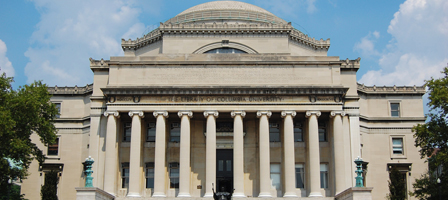Excerpt from Wikipedia, the free encyclopedia
The Low Memorial Library is the administrative center of Columbia University. Built in 1895 by University President Seth Low in memory of his father, Abiel Abbot Low, and financed with $1 million of Low’s own money due to the recalcitrance of university alumni, it is the focal point and most prominent building on the university’s Morningside Heights campus. The steps leading to the library‘s columned facade are a popular meeting place for Columbia students, as well as home to Daniel Chester French’s sculpture, Alma Mater, a university symbol. Low Library was officially named a New York City landmark in 1967, then a National Historic Landmark 20 years later.[2][3][4]
It is capped by the largest freestanding granite dome in the United States.[5]
Architecture
Low Library was designed by the architectural firm of McKim, Mead, and White, which was responsible for the design of much of Columbia’s Morningside Heights campus. The library was designed in the neo-classical style, incorporating many of the elements of Rome’s Pantheon. The building is in the shape of a Greek Cross and features windows modelled on those of the Baths of Diocletian. The columns on the library’s front facade are in the Ionic order, suited to institutions of arts and letters. An inscription on the building’s attic describes the history of the university.
The interior abounds with classical references. At the entryway are bronze busts of Zeus and Apollo. The foyer contains a white marble bust of Pallas Athena, modeled after the Minerve du Collier at the Louvre and donated by Jonathan Ackerman Coles of the Columbia College Class of 1864, an alumnus of Columbia’s Philolexian Society. She is surrounded there by the twelve signs of the zodiac. The 106-foot-tall (32 m) rotunda, formerly the library reading room when the building was used for its original function, is lined with columns of solid green Connemara marble from Ireland, topped with gold capitals. Roman and Greek philosophers Demosthenes, Euripides, Sophocles, and Augustus Caesar stare down from the rotunda’s heights as the four points of knowledge, Law, Philosophy, Medicine, and Theology mark the four points of the Greek Cross. The rest of the interior is finished with Italian and Istrian marble.
Text is available under the Creative Commons Attribution-ShareAlike License; additional terms may apply. See Terms of use for details.
Wikipedia® is a registered trademark of the Wikimedia Foundation, Inc., a non-profit organization.
Learn more and read the complete article on Wikipedia: Low Memorial Library
Copyright © 2011 • KLM, Inc. • All Rights Reserved






